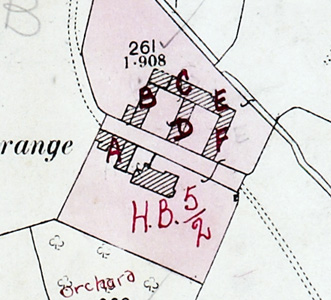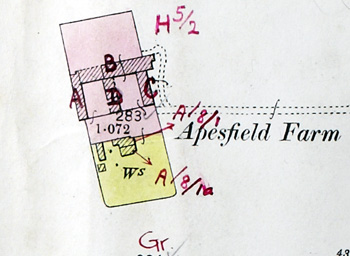Utcoate Grange Woburn

Utcoate Grange Farm on the map accompanying the 1926 valuation
Utcoate Grange sits in a dip in the landscape almost resembling a tiny portion of the North York Moors or the Cotswolds rather than Bedfordshire. The farm really was a grange – a set of outlying farm buildings owned by a religious house, in this case Woburn Abbey. Volume III of The Victoria County History for Bedfordshire was published in 1912 and wrote of Utcoate Grange thus: “The abbot in the early half of the 14th century leased the great ox stall and dairy at Utcoate, with various crofts and closes “with quick hedges and dikes”, the right to take bracken on Charlewood heath and common at Utcoate at all times of the year to Simon Cole, Isabella his wife, and Robert his son to hold for their lives”. There was a “warren of coneys” at Utcoate, which Henry VIII in 1539 leased with the grange to John Williams for twenty one years. In 1547 the grange was included in the grant made by Edward VI to Lord Russell, and it is now the property of the Duke of Bedford. In 1306 the Abbot of Woburn was concerned in a suit respecting the boundaries of Utcoate. He claimed that a pasture called Horthornes was within its boundaries, whilst Adam de Osgodby maintained that it was in Wavendon in Buckinghamshire. At the time of the Dissolution of the Monasteries Utcoate was valued at £35 3s. 4d. yearly”. Thus for the vast majority of its history the grange was held from Woburn Abbey, whether owned by sacred or secular masters. The warren may have been at Pumpkin Park, the wooded area on the road above Utcoate Grange, which looks to contain a series of man-made mounds and ditches consistent with a warren.
Directories for Bedfordshire from the mid 19th to the mid 20th century, were not printed annually but every few years. Utcoate Grange is first listed in 1847 when Joseph Circuitt was the tenant. Charles Readman was tenant in 1854 and Mrs. R. L. Crouch in 1864 and 1869. In 1877, 1885 and 1890 the tenant was William Gibbons Duncombe and John Watson in 1894, 1898, 1903, 1906, 1910 and 1914. Edward Brown Watson was the tenant in 1920 and Edmund Bowman Watson in 1924, 1928, 1931, 1936 and 1940, the last directory for the county.
The Rating and Valuation Act 1925 specified that every building and piece of land in the country was to be assessed to determine its rateable value. Utcoate Grange Farm was assessed on 29th July 1926 and the valuer visiting, in the afternoon, noted that it was still owned by the Duke of Bedford’s London and Devon Estates Company.
Unlike Birchmoor Farm and Job’s Farm, which were farmed directly by the Estate, Utcoate Grange was let – as we have seen, to Edmund Bowman Watson - for £410/10/- per annum. His acreage was 431½, an increase from before the Great War of half an acre. The rent, set in 1924, compared with the previous figure of £279, fixed in 1914. The valuer noted: “Water: good well and brook: Lighting lamps. Market Leighton Buzzard 6 miles. Station Woburn Sands 3¼ miles. Saw Mrs. Watson who says that the land up near Sheep Lane is very heavy and wet; this probably due to clay subsoil as well as to inefficient drainage”. Another hand noted, on 17th September 1926: “A Wold Farm. Arable land is very foul” and, on 5th November: “Range of poor buildings”.
The farmhouse comprised three reception rooms, a kitchen, a pantry, a hall, a dairy and cellar in the basement with five bedrooms, a bathroom with hot and cold running water and a W. C. on the first floor. Two attic rooms lay on the second floor. In the yard lay a weather-boarded and slated washhouse, wood house, coal house and two earth closets.
The farm was combined with Apesfield Farm (today’s Aspen Farm) which had no farmhouse. The homestead at Utcoate comprised the following:
- A: two coachhouses and a nag stable for three;
- B: a fowl house, a cowhouse for six, including two boxes and a three bay cowshed with a covered pen in front;
- C: a lean-to wood and corrugated iron hovel, a barn, a three bay Cartshed with a granary over and a five bay Dutch barn;]
- D: a pig house with four pens inside, a mixing house and a loose box for two horses;
- E: a cowhouse for six and a straw house;
- F: A cowhouse for eight, a cowhouse for six, a lean-to wood and corrugated iron implement shed and a five bay lean-to wood and corrugated iron hovel.
Apesfield Farm’s homestead was as follows:
- A: a wood and corrugated iron lean-to hovel, a brick and slate cowhouse for thirteen and a box for two;
- B: an earth closet, a five bay open Cartshed, a brick and slate barn with a granary over, a grain store, a mixing house, a chaff house and a coachhouse and pump;
- C: a carthorse stable for twelve and a chaff store;
- D: a three bay open cowshed with a covered pen, a covered calf pen, a wood calf house and a three bay open cowshed with a covered pen.
On 17th October 1940 an unexploded German bomb was reported at Utcoate Grange [WW2/AR/CO/2/2]. On 13th November that year another was reported at Apesfield Farm.
In March 1987 Utcoate Cottage was listed by English Heritage as Grade II, of special interest. The cottage dates from the 18th and 19th century, though some of it may be earlier. Much of the ground floor is constructed of coursed ironstone rubble. Elsewhere the building material is red brick, some laid in a chequerwork pattern, the 19th century bricks being laid plain. The roofs are composed of 20th century tiles. The main block has two storeys and attics with 18th and 19th century two storey additions to the north.

Apesfield Farm on the map accompanying the 1926 valuation